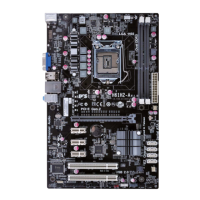
Do you have a question about the ECS H61H2-A and is the answer not in the manual?
| Memory channels | Dual-channel |
|---|---|
| Number of memory slots | 2 |
| Supported memory types | DDR3-SDRAM |
| Maximum internal memory | 16 GB |
| Supported memory clock speeds | 1066, 1333 MHz |
| Processor socket | LGA 1155 (Socket H2) |
| Processor manufacturer | Intel |
| Compatible processor series | Intel Celeron, Intel Pentium |
| Power fan connector | Yes |
| Number of SATA II connectors | 4 |
| USB 2.0 ports quantity | USB 2.0 ports have a data transmission speed of 480 Mbps, and are backwards compatible with USB 1.1 ports. You can connect all kinds of peripheral devices to them. |
| Firewire (IEEE 1394) ports | 0 |
| Audio chip | Realtek ALC662 |
| Component for | PC |
| Motherboard chipset | Intel® H61 |
| Audio output channels | 5.1 channels |
| Motherboard form factor | ATX |
| Supported storage drive interfaces | SATA II |
| Parallel processing technology support | Not supported |
| PCI Express x1 slots | 3 |
| LAN controller | Realtek RTL8111E |
| Networking features | Gigabti Ethernet |
| Ethernet interface type | Fast Ethernet, Gigabit Ethernet |
| BIOS type | AMI |
| ACPI version | 3.0 |
| BIOS memory size | 32 Mbit |
| Depth | 195 mm |
|---|---|
| Width | 305 mm |
Details the technical specifications and features of the motherboard, including chipset and processor support.
Lists key specifications like CPU socket, memory support, expansion slots, and I/O ports.
Visual identification and labeling of physical motherboard components with numerical references.
Essential safety guidelines and criteria for choosing a compatible computer case.
Step-by-step guide for safely installing the CPU into the LGA1155 socket.
Instructions for installing DDR3 SDRAM modules into the motherboard slots.
Guide to installing add-on cards into PCI and PCI Express slots.
Connecting front panel headers, rear I/O ports, and internal case elements to the motherboard.
Guide to accessing, navigating, and basic setup of the BIOS utility interface.
Explains keyboard shortcuts and the main BIOS screen layout for system configuration.
Settings for CPU configuration, fan control, voltages, and power saving features.
Configuration options for SATA, USB, and serial/parallel ports.
Settings for North Bridge, South Bridge, integrated graphics, and ME subsystem.
Options for tuning system performance, clock speeds, and memory voltage.
Configuring boot order, NumLock state, and system security passwords.
Procedures for saving or discarding BIOS changes and exiting the utility.
Instructions for installing drivers and utilities from the provided software disc.
Step-by-step guide for installing and configuring the eJIFFY fast boot utility.
Procedures for creating, deleting, and resetting RAID volumes using Intel Matrix Storage Manager.
Common issues during assembly and after prolonged use, with troubleshooting tips.
Recommendations for maintaining the motherboard's longevity and performance.
Visual guide to diagnose and resolve common PC startup issues.
